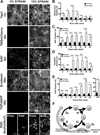Cell adhesion. Mechanical strain induces E-cadherin-dependent Yap1 and β-catenin activation to drive cell cycle entry
- PMID: 26023140
- PMCID: PMC4572847
- DOI: 10.1126/science.aaa4559
Cell adhesion. Mechanical strain induces E-cadherin-dependent Yap1 and β-catenin activation to drive cell cycle entry
Abstract
Mechanical strain regulates the development, organization, and function of multicellular tissues, but mechanisms linking mechanical strain and cell-cell junction proteins to cellular responses are poorly understood. Here, we showed that mechanical strain applied to quiescent epithelial cells induced rapid cell cycle reentry, mediated by independent nuclear accumulation and transcriptional activity of first Yap1 and then β-catenin. Inhibition of Yap1- and β-catenin-mediated transcription blocked cell cycle reentry and progression through G1 into S phase, respectively. Maintenance of quiescence, Yap1 nuclear exclusion, and β-catenin transcriptional responses to mechanical strain required E-cadherin extracellular engagement. Thus, activation of Yap1 and β-catenin may represent a master regulator of mechanical strain-induced cell proliferation, and cadherins provide signaling centers required for cellular responses to externally applied force.
Copyright © 2015, American Association for the Advancement of Science.
Figures




Comment in
-
Mechanotransduction: Adhesion forces promote transcription.Nat Rev Mol Cell Biol. 2015 Jul;16(7):390. doi: 10.1038/nrm4017. Epub 2015 Jun 17. Nat Rev Mol Cell Biol. 2015. PMID: 26081610 No abstract available.
-
Re: Cell Adhesion. Mechanical Strain Induces E-Cadherin-Dependent Yap1 and β-Catenin Activation to Drive Cell Cycle Entry.J Urol. 2016 Jan;195(1):220. doi: 10.1016/j.juro.2015.10.010. Epub 2015 Nov 21. J Urol. 2016. PMID: 26699994 No abstract available.
References
-
- Chen CS, Tan J, Tien J. Mechanotransduction at cell-matrix and cell-cell contacts. Annu. Rev. Biomed. Eng. 2004;6:275–302. - PubMed
-
- Engler AJ, Sen S, Sweeney HL, Discher DE. Matrix Elasticity Directs Stem Cell Lineage Specification. Cell. 2006;126:677–689. - PubMed
-
- Dupont S, et al. Role of YAP/TAZ in mechanotransduction. Nature. 2011;474:179–183. - PubMed
Publication types
MeSH terms
Substances
Grants and funding
LinkOut - more resources
Full Text Sources
Other Literature Sources

